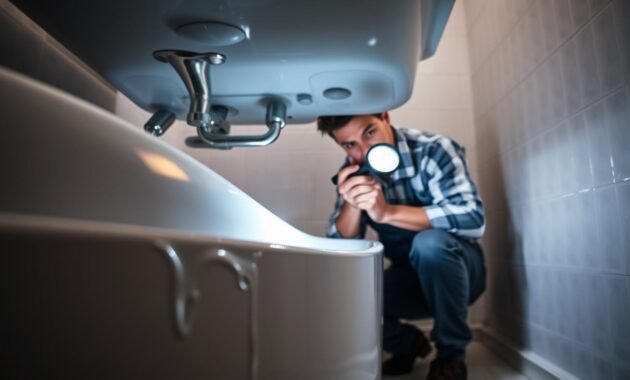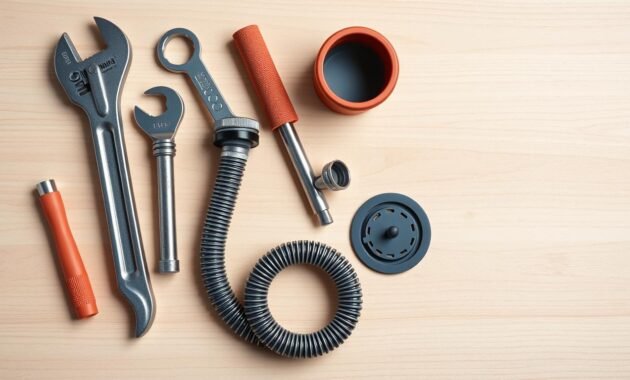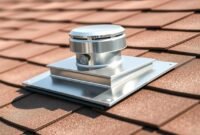Water leaking from under your bathtub can be very worrying. It might start with a small puddle but can quickly become a big problem. These leaks can harm your home’s foundation, cause mold, and cost a lot to fix.
I’ll show you how to spot leaks, find out why they happen, and fix them. You’ll learn about DIY fixes and when to call a professional. This guide will help you deal with water leaks from your bathtub.

Understanding Bathtub Leaks and Their Impact on Your Home
Water problems in your bathroom can quickly turn into a big issue. Bathtub leaks can harm your home’s structure and health. Spotting leaks early can save you money and avoid big water damage problems.
Read also: Why is Water Leaking from the Bottom of Water Heater
Finding a leak early needs careful watching and knowing the signs. Here are the key signs that your bathtub’s water system might be at risk.
Telltale Signs of Hidden Water Damage
- Unexpected water stains on ceiling beneath the bathroom
- Soft or spongy floor around the bathtub area
- Musty odors in the bathroom or adjacent rooms
- Visible mold growth on walls or baseboards
- Unexplained increases in water bills
Potential Risks of Ignoring Bathtub Leaks
Ignoring these signs can cause big problems. Water can harm your home’s foundation and create mold. The longer you wait, the more it will cost to fix.
| Leak Stage | Potential Damage | Estimated Repair Cost |
|---|---|---|
| Early Detection | Minimal Water Damage | $200 – $500 |
| Advanced Leak | Structural Damage | $2,000 – $10,000 |
| Severe Damage | Complete Renovation | $10,000 – $50,000 |
Health and Safety Implications
Leaks also pose health risks. Mold from moisture can cause breathing problems and allergies. Keeping your home safe means keeping your family healthy.
Water Leaking from under Bathtub: Common Causes and Solutions
Water leaking from under your bathtub can be really frustrating. As a homeowner, it’s important to know why these leaks happen. This knowledge helps prevent water damage and expensive fixes.
Now, let’s look at the main reasons for bathtub drain leaks:
- Cracked bathtub surface
- Deteriorating grout and caulk
- Damaged drain assembly
- Loose or worn-out seals
- Faulty overflow pipe connections
A common problem is a bad seal between the tub and drain. These seals can break over time, letting water leak under your bathtub. Older homes are more likely to have these leaks because of wear and tear.
Read aslo: Reasons Why There Is Water Leak Inside Refrigerator
Grout and caulk are key in keeping water out. If they crack or wear off, water can leak and damage your bathroom’s floor and walls. It’s a good idea to check these areas every year and reseal them if needed.
The drain assembly itself can also leak. Corroded pipes, loose connections, or damaged parts can let water escape. Fixing these problems early can save you from bigger and more costly repairs later.
Identifying the Source of Bathtub Leaks
Finding a bathtub leak is like solving a puzzle. Water damage can appear anywhere, making it hard to find. I’ll show you how to find where water might be leaking in your bathroom.

Visual Inspection Techniques
Start by looking closely at your bathtub. Check these spots:
- Examine the caulk and grout around the bathtub for visible cracks
- Inspect the overflow drain for signs of damage
- Look for water stains on ceiling or floor beneath the bathroom
- Check for moisture buildup around bathroom walls
Professional Leak Detection Approaches
When you can’t find the leak yourself, plumbers have tools to help. They use special methods to find hidden leaks.
Moisture Meters and Advanced Tools
Technology has made finding leaks easier. Moisture meters and infrared cameras can spot leaks you can’t see. These tools help find problems early, saving you money on repairs.
Using both visual checks and professional tools, you can quickly find and fix bathtub leaks.
Essential Tools and Materials for Bathtub Leak Repairs
When you’re fixing bathroom issues, the right tools are vital. I’ve found that being prepared is key to fixing bathtub leaks. It makes your DIY plumbing repairs much easier.
Before you begin, make sure you have these important tools and materials:
- Tub drain remover wrench
- Flathead screwdriver
- Plumber’s putty
- Replacement drain assembly
- Silicone caulk
- Adjustable wrench
- Protective gloves
- Clean rags or towels
Experts say good tools are essential for bathroom fixes. A tub drain remover wrench can save you a lot of time and hassle. If you don’t want to buy tools, many stores rent them for plumbing jobs.
Read also: How to Fix Toilet Bowl Losing Water
I suggest making a DIY plumbing repair kit with these items. It helps you fix small leaks fast and avoid water damage in your bathroom.
Pro tip: Always check your drain parts before buying new ones. Sometimes, a simple fix can save you money and time.
Step-by-Step Guide to Fixing Bathtub Drain Leaks

Fixing a bathtub drain leak might seem hard, but it’s doable with the right steps. I’ll show you how to tackle water leaks and get your bathtub working right again.
First, make sure you have these tools ready:
- Tub drain wrench
- Screwdriver
- Plumber’s putty
- Clean rags
- Replacement gasket
Removing the Old Drain Assembly
When fixing a bathtub drain, being precise is important. Use your tub wrench to loosen the drain. Put the screwdriver in the small hole for more power. Turn the wrench counterclockwise to take out the old drain.
Installing New Components
After taking out the old parts, clean the area well. Remove old plumber’s putty and check the surface. Put the new gasket in the drain hole. Then, put plumber’s putty around the drain to seal it tight.
Testing the Repair
Put the drain parts back together and turn on the water slowly. Look for leaks. Wait 24 hours before using the bathtub fully. This lets the putty set and seals the drain well.
Doing DIY plumbing repairs can save you money and make you feel proud. With patience and careful steps, you can fix most bathtub drain problems on your own.
Read also: How to Fix a Leaking Plastic Water Pipe
Dealing with Overflow Pipe and Plumbing Issues
The overflow pipe is key in bathroom repair but often ignored. I’ll explain how to handle plumbing leaks in your bathtub’s overflow system.
A bathtub overflow pipe stops water from overflowing by sending extra water down the drain. If it fails, you must act fast to avoid water damage in your bathroom.
- Inspect the overflow cover for signs of wear
- Check for water stains around the overflow area
- Listen for dripping sounds behind the tub
To fix the overflow cover and leaks, follow these steps:
- Unscrew the overflow cover plate carefully
- Remove the old drain assembly
- Inspect the gasket for damage
- Clean the flange thoroughly
- Install a new gasket
- Reposition and tighten the overflow cover
| Problem | Potential Cause | Solution |
|---|---|---|
| Water around overflow | Damaged gasket | Replace gasket |
| Loose cover | Worn mounting hardware | Tighten or replace screws |
| Persistent leaking | Corroded pipe | Professional pipe replacement |
Keep your tools ready and work carefully. If unsure, call a professional plumber to avoid more damage to your bathroom.
Preventive Maintenance Tips to Avoid Future Leaks
Keeping your bathroom safe from water damage is easier than fixing it later. Home maintenance tips can save you a lot of time and money. Preventing leaks in your bathtub is much simpler than fixing water damage.
Preventing water damage starts with regular bathroom care. Here are some important steps to keep your bathtub and plumbing in good shape:
- Check your bathtub and the area around it every month
- Keep the drain and overflow clean to stop buildup
- Change the caulking and grout every 2-3 years
- Use drain covers to catch hair and other debris
- Look for signs of leaks in pipe connections
Fixing bathroom problems is easier if you catch them early. I suggest making a routine to check seals, examine grout, and ensure good drainage.
| Maintenance Task | Frequency | Purpose |
|---|---|---|
| Caulk Inspection | Every 6 months | Prevent water seepage |
| Drain Cleaning | Monthly | Prevent clogs and buildup |
| Grout Repair | Every 2-3 years | Maintain watertight seal |
Spending a bit of time on preventive maintenance can save you a lot of money. By being careful and fixing small problems fast, you’ll keep your bathroom safe and your bathtub lasting longer.
Conclusion
Water leaking from under your bathtub can be a big problem. I’ve shown you how to find, fix, and stop these leaks. Knowing the signs and acting fast can save you a lot of money and time.
Keeping your home in good shape is key when dealing with leaks. Each leak is different, but the main steps are the same. You need to spot it early, check it well, and fix it fast. You can do it yourself or get help from a pro, but the important thing is to catch it before it gets worse.
My advice is simple: keep an eye out, act fast, and get help when you need it. By following the tips we’ve talked about, you’ll keep your home safe and your bathroom working right. Being proactive can save you from expensive fixes and give you peace of mind.
Remember, a well-kept bathroom is an investment in your home’s value and your family’s happiness. Regular checks and quick fixes are your best defense against water damage and renovation troubles.


